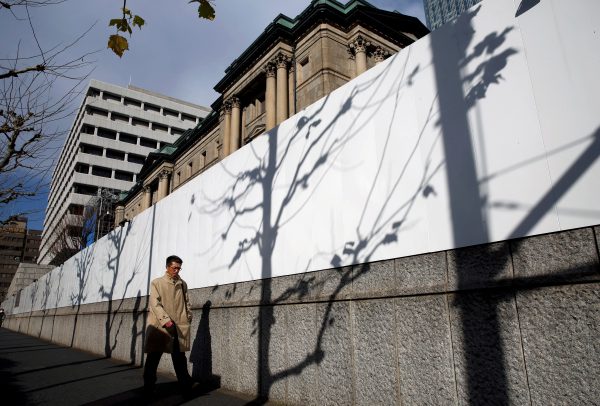As the gap grows between interest rates on 10-year government bonds in Japan and those in the United States and Europe, investors are withdrawing money from Japan. That has caused the yen to drop like a rock. Since July 2021, there has been an extremely high correlation (97 per cent) between movements in the interest rate gap and movements in the yen to dollar exchange rate. A weaker yen hurts Japanese households by raising prices for food and energy and hurts many companies by raising the prices of vital inputs.
Kuroda has consistently denied the dilemma, claiming that a weak yen is a ‘net benefit’ because it boosts Japan’s exports. But with the yen so weak, the costs have become greater than the benefits.
A weak yen, along with hikes in the consumption tax and COVID-19, is one of the reasons that consumer spending has been stagnant for years and is now 4 per cent lower than it was in 2013. In June 2022, nearly half of Japanese companies said the weak yen was hurting their business, while 3 per cent said it was helping. As the BOJ acknowledges, a weak yen does not boost exports as much as it did in the past.
Kuroda is correct that the bouts of inflation hitting Japan, the United States and Europe are different and require different responses. Japan’s headline inflation is far below that in the United States and Europe — it was 2.2 per cent in Japan in April–July 2022 compared to 8.6 per cent in the United States and 8.1 per cent in the Eurozone.
More importantly, an overwhelming 88 per cent of Japan’s inflation stems from import-intensive food and energy, even though these items make up only 27 per cent of consumer spending. All the remaining items — known as ‘core’ inflation — account for a paltry 12 per cent of Japan’s inflation, far below the 61 per cent share in the United States and 32 per cent in the Eurozone.
Core inflation is a better predictor of longer-term trends. Japan’s core inflation was just 0.4 per cent in July 2022 — far below the BOJ’s 2 per cent goal. By contrast, core inflation has soared to 6 per cent in the United States and has reached 4 per cent in the Eurozone. That is why Kuroda sees Japan’s inflation as transitory, with no need to hike interest rates. In its July Outlook report, the BOJ predicted that consumer prices (aside from fresh food) would fall back to 1.2–1.5 per cent in the fiscal year 2023.
The cause of Japan’s inflation is different from that in the United States and, to some degree, in Europe. In the United States, inflation is largely the result of excess demand that causes the economy to overheat. In that situation, hiking interest rates can slow demand and bring it back into balance with supply. Unfortunately, this is hard to execute without provoking a recession.
Japan suffers mainly from ‘cost-push’ inflation by which the price of vital inputs has risen, sometimes because they are much harder to get. For example, the semiconductor shortage hampering auto production and Russia’s cutoff of oil and gas to Europe have caused prices to climb even as GDP slows — a phenomenon called ‘stagflation’. Europe’s inflation is more balanced between demand-pull and cost-push forces.
In Japan’s case, Kuroda argues that raising interest rates would undermine both GDP growth and the BOJ’s effort to attain a healthy demand-led 2 per cent inflation rate. It certainly will not relieve supply-chain shortages or price hikes.
While this is correct, it ignores the negative impact of a weakening yen. Currency traders keep going back and forth on the trajectory of the yen based on their estimates of US inflation and interest rates. A minority of financial traders believe Kuroda will sooner or later be compelled to let 10-year bond rates rise above 0.25 per cent, but so far the BOJ has defeated their attempts to force its hand.
The good news for Kuroda is that even though the US Federal Reserve (Fed) is raising overnight rates — its main policy instrument — such hikes do not move 10-year bond rates to the same degree. So it remains to be seen where the 10-year rate will go as the Fed continues raising rates. Financial markets are going through big mood swings about the path of the yen.
Neither raising interest rates nor keeping them near zero will solve Japan’s problems because the BOJ’s dilemma reflects larger structural defects. Years of wage suppression have crimped private demand so badly that Japan has become addicted to zero interest rates and big budget deficits just to keep the economy afloat.
While rising international interest rate gaps triggered the yen’s current plunge, the fact that, in price-adjusted terms, the yen is the weakest it has been since 1971 reflects the long deterioration in Japan’s competitiveness. Great harm has resulted from the Abe administration’s illusion that easy money and a cheap yen could solve these bigger problems.
Tokyo’s latest gambit to avoid facing its dilemma was a currency intervention on 22 September. Most currency analysts do not believe this will have any lasting impact on the trajectory of the yen, which is being pushed around by fundamental factors rather than mere speculation. History is on the side of these analysts.
Richard Katz is Senior Fellow at the Carnegie Council for Ethics in International Affairs. This article is digested from Japan Economy Watch, parts 1 and 2.

